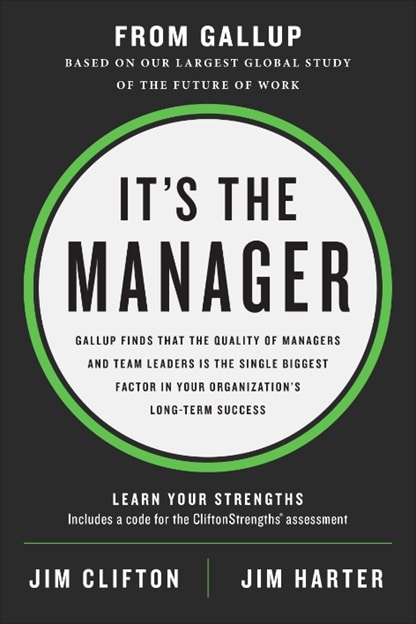
The single biggest factor in your organization’s long-term success
(according to the new book by Gallup)
Gallup organization conducted “the largest study on the future of the workplace.” After Tens of Millions of In-Depth Interviews With Managers, Employees, Economists and Leading Organizations – the single biggest factor in any organization’s long term success is … Please read along to find the research answer and the book on the same topic by Gallup.

You can buy the book by clicking here – (This is a Non-affiliate link)
Gallup – The leader in scientific polling
Gallup organization is an American analytics and advisory company founded by George Gallup in 1935. It is the pioneer in scientific polling. In 1936 the influential magazine “The Literary Digest” predicted that Alfred Landon would win the U.S. presidency. Contrary to the popular, Gallup correctly predicted the winner – Franklin Roosevelt. This event popularized the company and made it a leader in American polling, which it has remained to date.
Gallup organization has conducted millions of polls worldwide over the last eight decades. In their latest book – It’s the Manager – CEO Jim Clifton and Chief workplace research scientist Jim Harter offer conclusions from their “largest study on the future of work.”
In-depth research of millions of data points
According to Gallup, the research for the book included –
- a review of everything we could find across almost all leading institutions and management literature — as well as our own data from more than 30 years of U.S. and global workplace tracking
- tens of millions of in-depth interviews with employees and managers across 160 countries
- in-depth round table interviews with CHROs from 300 of the world’s largest organizations
- interviews with several of the world’s preeminent economists
The major problem of businesses worldwide
From the research study, Gallup concluded that the short-term (5-10 years) problem worldwide and businesses worldwide was declining productivity – as measured by GDP per capita. The main culprit for the slowdown in productivity is the failure to maximize human potential. Lean management and Six Sigma have helped improve the processes and the quality of global production. Over the last thirty years, the “defects” in processes have been eliminated largely. However, according to the book, the “defects” in how organizations manage their human capital needs to be worked on.
Failure in maximizing human potential
Today – Organizational defects “aren’t failures in processes but failures in maximizing the human potential” Over the last thirty years, the business environment and how people work has changed at an unprecedented level. People want to work, live, and connect with others in dramatically different ways. But how we manage has been stuck in a time capsule over that period. Productivity growth has stalled because organizations are not maximizing the potential of their employees. Outdated management practices have stifled employee engagement and productivity.
Read: Organizational culture Change – The Ford turnaround story by Alan Mulally
It’s the Manager – the single biggest factor to any organization’s long-term success.
Research also concluded that the managers or team leaders account for 70% of the variance in employee engagement scores. And hence the title of the book – It’s the Manager – Gallup finds that the quality of managers and team leaders is the single biggest factor in your organization’s long-term success.
The book offers leaders and aspiring leaders 52 tips to maximize human potential in organizations. These 52 tips are divided into five major headings.
- Strategy: How to use strategy to create a culture of high performance. Teams that work together and make quick decisions.
- Culture: Some insights based on the research on why culture is probably the most important factor in organizations’ success.
- Employment Brand: Millennials think differently. Tips for creating a culture and a brand that allows companies to attract, hire, and keep the best talent. How to work on creating a workplace that is desired and coveted by talented employees.
- Boss to Coach: Command and control are officially dead. How to change managers’ approach from bosses to coaches to serve the needs and wants of employees. Today employees want managers who help them utilize and maximize their talents and not fit them into a standard job description.
- The Future of Work: One size fits all does not work in a rapidly changing workplace. Managers must be agile and responsive to constant and never-ending changes such as diversity and inclusion, artificial intelligence, analytics, remote work, and flexible schedules. Training managers for such a business world is essential.
Read: Guaranteed measurable results delivered for our FMCG client
How do organizations achieve these outcomes?

According to the book, culture change begins with changing the beliefs of CEOs and CHROs. As the authors point out, the management practices have not kept up with workplace changes and changes in employee’s expectations. The next step is changing what the managers and team leaders believe.
For decades, shareholder returns have been the holy grail of businesses. However, things have changed. In a “purpose” driven economy, people’s needs have to be a priority, or else there will be no improvement in productivity. If companies learn, change, and adapt to new ways to manage people and teams, the growth in productivity, revenue, profits, and employee engagement will be dramatic. The new purpose of business, which is also to the future of work, includes maximizing human potential. The book argues that this change in mindset will change everything.
Read: Psychological safety at work – Why you need it and how to develop it
NAL Triple Advantage Leadership Coaching
That delivers guaranteed and measurable leadership growth. It is based on a stakeholder centered coaching process with a 95% effectiveness rate (in a study of 11000 leaders on 4 continents). It is used by companies ranging from startups to 150 of the Fortune 500 companies to develop their leaders.
Here are some of the salient benefits of NAL Triple Advantage Leadership Coaching
Time and resource-efficient: The leader does not have to leave work to attend training programs. We go to the leader and her team. And it only takes 1.5 hours per month. The rest of the time, the leader is working to implement with her team.
Separate and customized improvement areas for each leader: Every leader is different. One size fits all approach doesn’t work. Individual development areas for each leader are aligned to the business strategy.
Involves entire team: Unlike most leadership programs, NAL Triple Advantage Leadership Coaching involves the leader’s entire team, and it has a cascading effect – increasing the team effectiveness and improving organizational culture.
The leader becomes the coach: for continuous improvement for leaders themselves and their teams. It is like kaizen for your leadership development.
Cost-Effective: Our entire one-year coaching engagement often costs less than sending the leader to a short-duration leadership program at any reputed B school.
Guaranteed and measurable leadership growth: as assessed – not by us – but anonymously rated by the leader’s own team members.
Pay us only after we deliver results!: We work with many of our clients on a pay for results basis. What does it mean? If the leaders don’t improve, you don’t have to pay us.
Schedule an exploratory 15-minute conversation with our leadership adviser today
Click the button below.
References
https://www.gallup.com/workplace/246092/new-book-uncovers-gallup-best-management-insights.aspx
